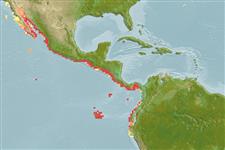Common names from other countries
Teleostei (teleosts) >
Carangiformes (Jacks) >
Carangidae (Jacks and pompanos) > Caranginae
Etymology: Caranx: French, carangue, the name of a Caribbean fish; 1836 (Ref. 45335).
More on author: Günther.
Environment: milieu / climate zone / depth range / distribution range
Ecology
Marine; brackish; pelagic-neritic; depth range 3 - 100 m (Ref. 9283). Subtropical; 34°N - 7°S, 121°W - 70°W
Eastern Pacific: Santa Cruz Island, California, USA to Peru, including the Gulf of California and the Galapagos Islands.
Length at first maturity / Size / Weight / Age
Maturity: Lm 26.5, range 17 - ? cm
Max length : 55.0 cm FL male/unsexed; (Ref. 9283); common length : 40.0 cm FL male/unsexed; (Ref. 9283); max. published weight: 2.8 kg (Ref. 40637); max. reported age: 8 years (Ref. 127563)
Adults are found on the continental shelf, generally near the coast but also in deeper waters; penetrated estuaries (Ref. 9283). They feed mainly on silver-colored fishes, but also take squids, shrimps and other invertebrates (Ref. 9283). Juveniles are often found in estuarine waters (Ref. 9283). Marketed fresh, salted or dried, and smoked; also utilized as fishmeal and source of oil (Ref. 9283).
Eschmeyer, W.N., E.S. Herald and H. Hammann, 1983. A field guide to Pacific coast fishes of North America. Boston (MA, USA): Houghton Mifflin Company. xii+336 p. (Ref. 2850)
IUCN Red List Status (Ref. 130435)
CITES (Ref. 128078)
Not Evaluated
Threat to humans
Harmless
Human uses
Fisheries: commercial
More information
ReferencesAquacultureAquaculture profileStrainsGeneticsElectrophoresesHeritabilityDiseasesProcessingMass conversion
Tools
Special reports
Download XML
Internet sources
Estimates based on models
Preferred temperature (Ref.
115969): 18.1 - 28.9, mean 25.5 (based on 100 cells).
Phylogenetic diversity index (Ref.
82804): PD
50 = 0.5000 [Uniqueness, from 0.5 = low to 2.0 = high].
Bayesian length-weight: a=0.01905 (0.01065 - 0.03411), b=2.97 (2.82 - 3.12), in cm Total Length, based on LWR estimates for this species & Genus-body shape (Ref.
93245).
Trophic level (Ref.
69278): 4.1 ±0.54 se; based on food items.
Resilience (Ref.
120179): Medium, minimum population doubling time 1.4 - 4.4 years (Preliminary K or Fecundity.).
Fishing Vulnerability (Ref.
59153): Moderate vulnerability (35 of 100).
